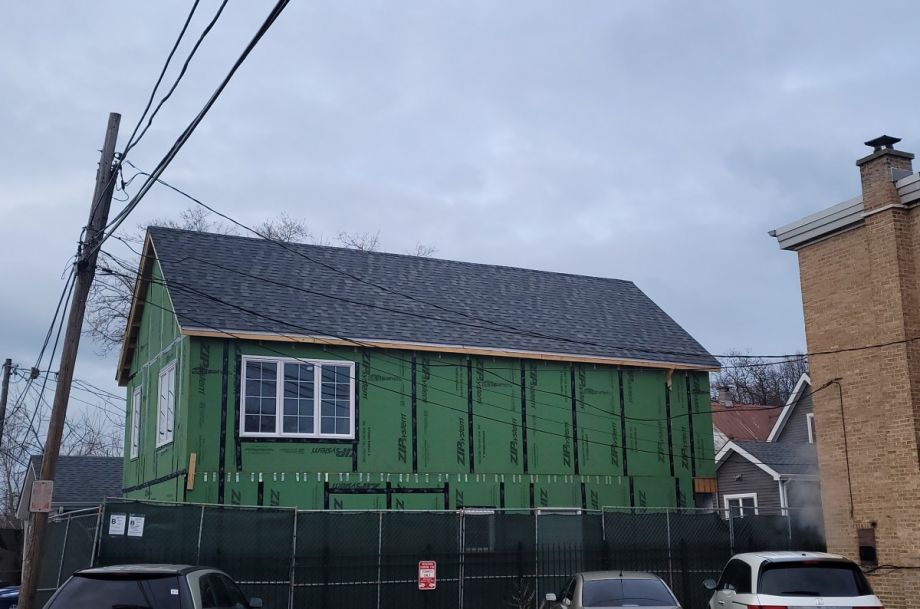Aaron Barnhart and Diane Eickhoff knew they wanted to sell their house in Kansas City, Missouri, to downsize. And as soon as Diane said she wanted to move back to Evanston, Illinois, where the couple had both lived for a decade, they knew exactly where in the city just north of Chicago they wanted to be: near the Reba Place Church. It’s where the couple met, where they got married, and where their community was centered. The church has a history as a progressive force in Evanston. As part of its social justice mission, it purchased multiple single-family homes during the “white flight” 1970s and rented them at below-market rates. The church functions as a “collective urban commune,” as Aaron describes it, as well as a place of worship.
Given the small radius they wanted to live in, they knew the market was going to be “super tight,” Aaron says. They didn’t want a large house or to be in a condo building. Through conversations with friends at the church, they learned that Evanston had recently changed its zoning to make accessory dwelling units (ADUs) — small-footprint housing commonly known as carriage houses or granny flats — easier to build. (The change took effect in 2020.) The church made a proposal: They could build an ADU in the backyard of one of the Reba properties. Saying yes was an easy decision.
“It’s more than just a house — it’s an urban planning tool,” Aaron says. “And it’s a social justice tool. But we just liked it because it would give us a house that checked all our boxes, including being right in the heart of the Reba community.”
Their perfectly sized house is being constructed by the Evanston Development Cooperative, a cooperatively owned builder that specializes in ADUs. The worker co-op is also a local advocate for the efficiently sized homes as a way to address the often-interlinked issues of race, climate change, and affordable housing. It was founded in 2018, the same time that the city took the first step to update its zoning code for ADUs.
“I think we accelerated what the city was already doing,” says Robinson Markus, one of EDC’s co-founders and co-owners. “We were intimately involved in these conversations on how to shape the policy.”
Before EDC’s founding, the city did the work of legalizing existing ADUs, which were technically illegal because of changes made to city zoning in the 1950s to prioritize single-family housing. In 2020, thanks in part to EDC’s advocacy, two additional key changes were made: allowing the construction of ADUs on any residential property and legalizing internal ADUs, such as an attic or basement conversion. Prior to the updates, only single-family homes and not duplexes — which are disproportionately in Evanston’s neighborhoods of color — were allowed to build ADUs. Resolving that line item was an equity issue, Markus says.
“Only certain parts of the city were allowed to build intergenerational wealth and increase their property value through this mechanism,” he says, “while other parts of the city were often being denied this opportunity.”
Last year, Evanston made history as the first city to institute a reparations program. It is specifically focused on mending the harms of “discriminatory housing policies and practices and inaction on the city’s part.” But over the past 20 years, the city’s Black population has been declining; many people cite the rising cost of housing as the reason, according to Markus. Last year, the median Evanston home sale price was $450,000.
“We are in such a crisis with the cost of housing that we have to put every option on the table,” Markus says. “Accessory dwelling units will not single-handedly alleviate the housing cost pressures facing our city. But on the other hand, it does not cost a city any dollars to amend its zoning code to allow for these units.”
Building ADUs might not be a silver bullet, but they can open up housing options in the city: According to EDC calculations, building ADUs on Evanston properties has the potential to add 10,000 additional housing units.
EDC has worked in collaboration with the city to demonstrate to residents the options they now have to build ADUs. With the city, they co-published an ADU guidebook for Evanston, including a step-by-step guide from zoning analysis to move-in. The co-op is also working with the city on an affordable housing pilot project, with one two-bedroom unit intended for a small family currently under construction behind a duplex. The pilot uses Housing and Urban Development funds specifically designated for nonprofit affordable housing developers. (A previous pilot financed by the city’s housing fund and a private homeowner did not pan out.)
And the units that EDC builds look to a climate change future. By design, ADUs increase density and decrease driving distances (or convert a drive into a walk). Their compact footprint means lower utility bills, as a smaller space takes less energy to heat and cool. They’re constructed of insulated panels that are extremely airtight, not allowing heat to seep out or cold air to creep in.
At their current scale, EDC is building one unit at a time. They have nine projects currently underway, including Aaron Barnhart and Diane Eickhoff’s future home. The couple’s motivation was to age in place, but other EDC clients include a duplex owner planning to move into an ADU in his backyard so he can stay in the neighborhood earning rent money from both units. Another client is building their unit as a home business.
Down the line, EDC’s vision is to scale up the operation while maintaining their worker-owned model.
“Yes, it’s about affordable housing,” Markus says. “Yes, it’s about climate action. But it’s also about the people who have called Evanston home far longer than I have, feeling like they have ownership and a sense of place in this community through a more democratic business.”
Editor’s Note: This article has been changed to correct Diane Eickhoff’s name.
This article is part of Backyard, a newsletter exploring scalable solutions to make housing fairer, more affordable and more environmentally sustainable. Subscribe to our weekly Backyard newsletter.

Ashira Morris is a freelance reporter based between Sofia, Bulgaria, and Tallahassee, Florida. Her work, focused on local environments and the forces that shape them, has been published by National Geographic, Foreign Policy, and the Guardian.


















